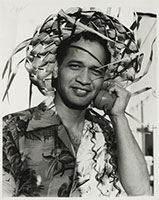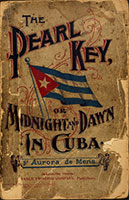 UF Center for Latin American Studies
UF Center for Latin American Studies
The Cuban American Dream exhibit has been digitized. The digital timeline offers audiences an interactive online experience, where viewers can engage with archival material on the history of Cuban immigration to Florida.

May 14, 2018 — Katiana M. Bagué
“Once on the boat, we had to wait for permission to sail. We waited and waited, but the Cuban government did not grant permission until a storm began. The storm and the mysterious companions made the passage to Miami dangerous and long.”
This excerpt comes from a longer testimony made by Roniel Cabrera, Associate Professor of Medicine at UF’s Division of Gastroenterology, Hepatology & Nutrition, who at eight years old was part of the thousands of Cubans who participated in the Mariel Boatlift. This testimony along with books, photographs and a collection of government documents, spanning from the sixteenth to the twenty-first century, was compiled and showcased in the Cuban American Dream, an exhibit curated by Margarita Vargas-Betancourt with assistance from Alexis Baldacci. It was put on display in the Smathers Library Gallery from March 27th to June 2nd, 2017, and it encouraged audiences to look at different perspectives regarding Cuban immigration to Florida. For instance, it analyzed the strife of Cuban-Americans as they adjusted to their new homeland and worked to attain a vision of the “American Dream.” I was fortunate enough to see this exhibit and as I wandered through the gallery space reading the materials in the display cases, I felt immersed in the Cuban immigration history. Because its stories can easily go underrepresented, it is crucial to tell them.
Refugees are processed inside a hangar in Key West's Truman Naval Base.
The exhibit, both innovative and engaging, seemed short lived. With the university’s Latin American and Caribbean Collection constantly acquiring new materials related to Cuban history, and with a large population of Cuban-Americans within the campus community, the information from the exhibit was both significant and relevant. Thus in order to continue to broadcast its content and the discussion about Cuban immigration, and immigration in general, within academic and community settings, Margarita and Alexis envisioned the creation of a digital timeline.
On October 2017, I was awarded the ARL Fellowship for Digital and Inclusive Excellence, an internship that allowed me to work closely with Margarita on digital projects for the Latin American and Caribbean Collection. When she presented me the timeline idea, I was both motivated and excited to be a part of a project I had interacted with before. A timeline was an appropriate format for this digital exhibit considering that its physical counterpart spanned a long time period. The project not only required me to transfer the information from the physical exhibit to a digital format but also to create new labels to include the most recent events of Cuban immigration to Florida. These were especially significant given the normalization of relations between the U.S. and Cuba (2014) and the subsequent slowdown of such process.

Arnold Eagle, Cuban man talking on the phone, circa 1950-1960
Special & Area Studies Collections, George A. Smathers Libraries, University of Florida
In this day and age, it seems that digital projects have become more doable and accessible. Timeline JS, an open source tool from Knightlab.com, helps users create visually engaging digital timelines with a simple four-step process. With a Google spreadsheet, I was able to add text alongside significant dates and insert images in jpeg format that were eventually displayed digitally in the timeline presentation. After this process, the final product was published unto the George A. Smathers webpage for online exhibits.

Aurora de Mena (Cuban), The pearl key, or midnight and dawn in Cuba, 1896
Vance Print. Co., 972.911 M534t
Rare Book Collection, Special & Area Studies Collections
George A. Smathers Libraries, University of Florida
Cuban American Dream Timeline not only preserves the original exhibit showcased back in 2017, but it also offers audiences an interesting interactive online experience. The viewer can engage with the archival material from the exhibit section by section, which can allow for deeper reflections and connections regarding the history of Cuban immigration to Florida. As proven with the recent presentations done by Margarita, the timeline can also be an engaging learning tool in classroom settings. It not only presents valuable information, but it can also inspire students to pursue their own digital projects related to their studies and research.
The timeline can be accessed via the George A. Smathers online exhibits webpage: http://exhibits.uflib.ufl.edu/cubanamericandream/